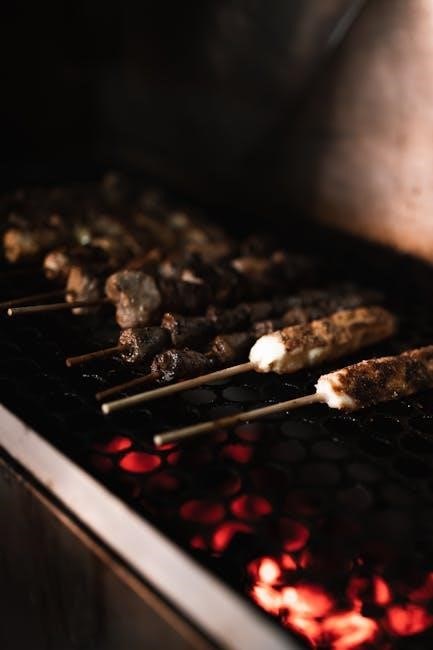Meat smoking is an art requiring precision, patience, and practice. A smoking chart serves as a vital guide, ensuring optimal temperatures, times, and wood pairings for perfect results. Downloadable as a PDF, it simplifies the process, helping beginners and experts achieve consistent, flavorful smoked meats safely and efficiently.
What is Meat Smoking?
Meat smoking is a slow cooking process that infuses rich, complex flavors into meats using low temperatures and smoke from burning wood. It involves exposing meat to controlled smoke environments, typically between 100°F and 300°F, over several hours or days. This method enhances tenderness, develops deep flavors, and preserves meat. A smoking chart is essential for guiding temperatures, times, and wood choices, ensuring perfectly smoked results every time.
Importance of Using a Smoking Chart
A smoking chart is crucial for achieving perfectly smoked meats. It provides detailed guidelines for temperatures, cooking times, and wood pairings, ensuring food safety and optimal flavor. By referencing a chart, smokers can avoid undercooked or overcooked meat, especially for tougher cuts like brisket or ribs. It also helps prevent bacterial growth in the “danger zone” (40-140°F), keeping meat safe to eat.
Beef Smoking Guide
Beef smoking is a low-and-slow process, typically at 225-250°F, requiring precise temperature control and patience. A smoking chart is essential for achieving tender, flavorful results.
Smoking Temperatures for Beef
Beef smoking typically occurs at 225-250°F, ensuring tender results. Brisket, a popular cut, smokes at 225-240°F for 12-20 hours, reaching an internal temperature of 145°F for safety and 195°F for optimal tenderness. Hickory, Mesquite, Oak, Pecan, and fruit or nut woods enhance flavor. Avoid using cedar, cypress, or pine for smoking. Always use a thermometer to monitor meat temperature for food safety and perfection.
Recommended Cooking Times for Beef Cuts
Beef brisket typically smokes for 12-20 hours at 225-240°F, reaching 195°F internally. Chuck roast cooks for 8-10 hours, achieving 200°F. Ribs take 5-6 hours, while tri-tip requires 4-6 hours. Internal temperatures are crucial for safety and tenderness. Use a thermometer to ensure accuracy, as times may vary based on meat size and smoker conditions.
Best Wood Chips for Beef Smoking
For beef smoking, Hickory, Mesquite, and Oak are popular choices, offering bold, smoky flavors. Pecan provides a nutty, slightly sweet taste, while fruitwoods like Cherry or Apple add a fruity complexity. Avoid using softwoods like pine or cedar, as they can impart harmful chemicals. Blending wood types can enhance flavor profiles, creating a balanced smoke for tender, flavorful beef dishes.
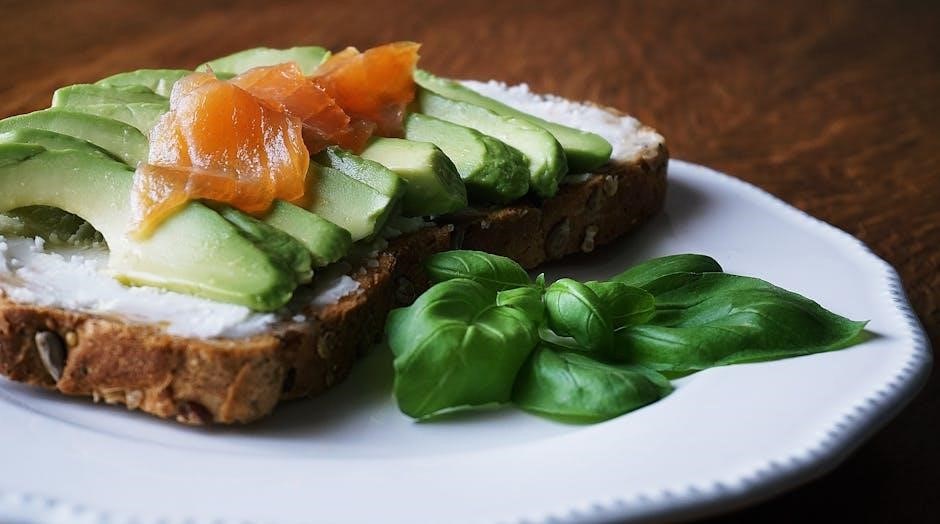
Pork Smoking Guide
A comprehensive guide to smoking pork, covering temperatures, times, and techniques for tender, flavorful results. Ideal for brisket, ribs, and roasts, ensuring perfectly smoked pork every time.
Smoking Temperatures for Pork
Pork smoking typically requires temperatures between 225-300°F, depending on the cut. For tender results, maintain a steady temperature, ensuring the meat reaches a safe internal temperature. Use a digital thermometer for accuracy and food safety.
Recommended Cooking Times for Pork Cuts
Smoking pork cuts requires precise timing for tenderness. Baby back ribs typically take 4-5 hours at 225-250°F, while pork shoulders need 8-12 hours. Pork belly and spare ribs usually take 6-8 hours. Always use a meat thermometer to ensure the internal temperature reaches 190°F for pulled pork and 160°F for ribs. Cooking times may vary based on size and smoker conditions.
Best Wood Chips for Pork Smoking
Hickory and apple wood are ideal for pork, adding rich, sweet flavors. Maple and cherry woods provide subtle, fruity notes, while pecan offers a nutty undertone. Blending hardwoods like oak with fruitwoods enhances complexity. Avoid softwoods like pine, as they can impart bitter tastes. Using high-quality, dry wood chips ensures a clean, consistent smoke flavor for tender, delicious pork dishes.
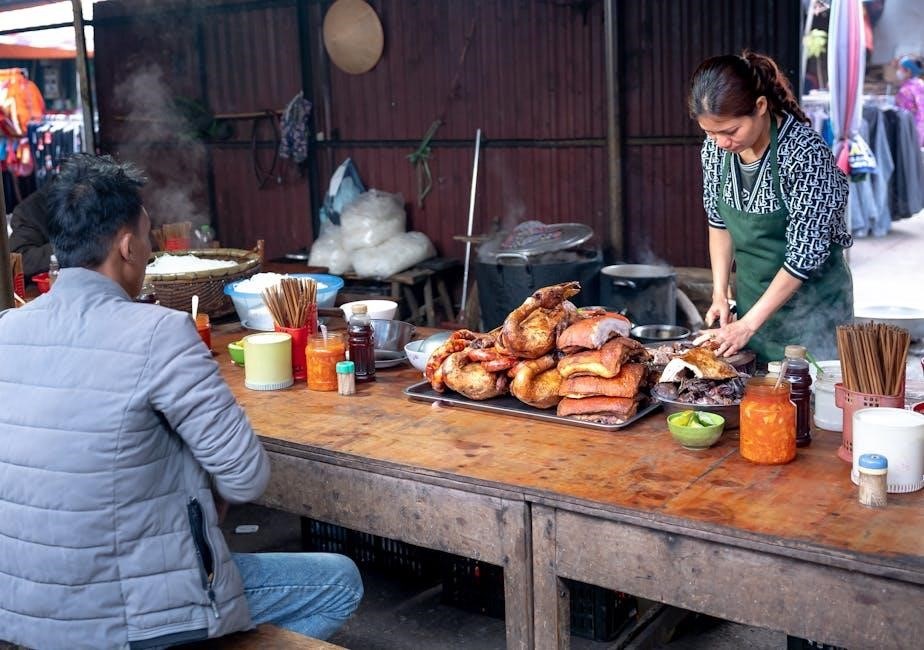
Poultry Smoking Guide
Smoking poultry enhances flavor and texture. Use a smoking chart PDF for precise temperatures and times. Chicken and turkey thrive at 225-275°F with apple, cherry, or maple wood.
Smoking Temperatures for Chicken and Turkey
For poultry, optimal smoking temperatures range between 225°F and 275°F. Chicken typically requires 4-6 hours, while turkey may take 6-8 hours. Always use a meat thermometer to ensure chicken reaches 165°F and turkey 180°F internally. Apple, cherry, or maple wood pairs perfectly with poultry, enhancing flavor without overpowering. A smoking chart PDF provides precise guidelines for achieving tender, juicy results.
- Chicken: 225-275°F, 4-6 hours, internal temp 165°F.
- Turkey: 225-275°F, 6-8 hours, internal temp 180°F.
Recommended Cooking Times for Poultry Cuts
Chicken and turkey cuts require precise cooking times for tender results. Whole chickens smoke for 4-6 hours at 225-275°F, while quarters, thighs, and wings take 2-4 hours. Turkey breasts need 4-6 hours, and legs 6-8 hours. Always aim for internal temperatures of 165°F for chicken and 180°F for turkey. A smoking chart PDF offers detailed timelines for various poultry cuts.
- Whole Chicken: 4-6 hours at 225-275°F.
- Chicken Quarters: 2-4 hours.
- Turkey Breast: 4-6 hours.
Best Wood Chips for Poultry Smoking
For poultry, lighter wood flavors enhance the natural taste without overpowering it. Apple, cherry, and maple woods are ideal, offering fruity, sweet notes. Citrus woods like orange or lemon add brightness. Avoid strong hardwoods like mesquite for poultry. A smoking chart PDF provides wood pairing recommendations, ensuring a balanced flavor profile.
- Apple Wood: Sweet, fruity flavor.
- Cherry Wood: Mild, slightly tart notes.
- Maple Wood: Subtle, smooth sweetness.
- Citrus Woods: Bright, zesty undertones.
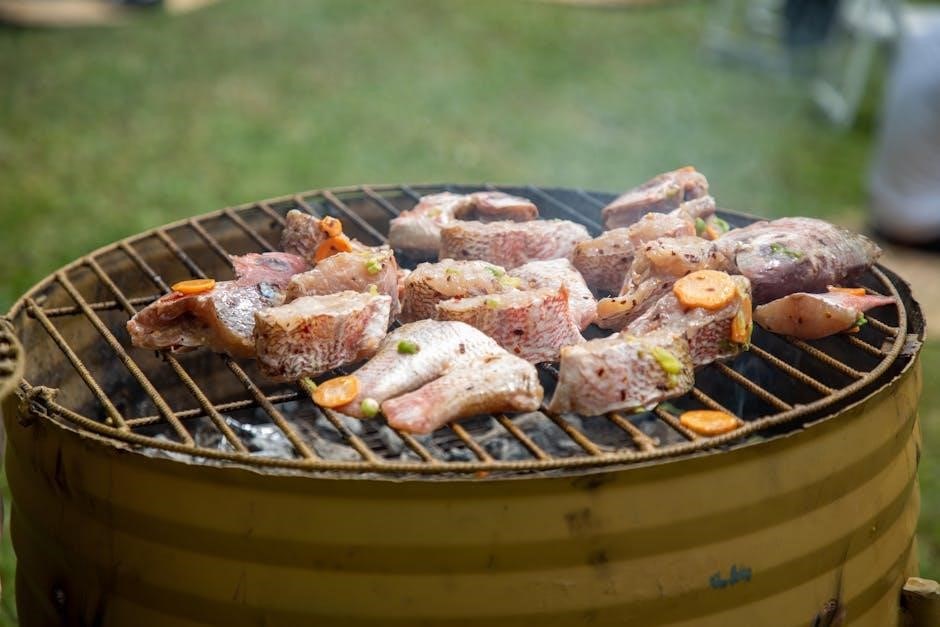
Fish and Game Smoking Guide
Smoking fish and game meats requires precise temperature control. Use a smoking chart PDF for guidance, with temperatures between 100-150°F. Opt for alder or apple wood for delicate flavors.
Smoking Temperatures for Fish and Game Meats
For fish, ideal smoking temperatures range between 100°F and 150°F, ensuring tender, flavorful results. Game meats like venison or elk typically smoke at 150°F to 200°F. Use alder or apple wood for fish to avoid overpowering their delicate flavor. For game, stronger woods like mesquite or hickory complement bold, earthy notes. Always refer to a smoking chart PDF for precise guidelines to achieve safe, mouthwatering dishes.
Recommended Cooking Times for Fish and Game Cuts
Delicate fish fillets smoke in 1-2 hours, while thicker cuts like salmon take 2-4 hours. Game meats such as venison or elk require 4-6 hours for tender results. Referencing a smoking chart PDF ensures precise timing, and using a meat thermometer guarantees perfectly cooked dishes each time.
Best Wood Chips for Fish and Game Smoking
For fish and game meats, choose wood chips that add subtle, complementary flavors. Alder and Wood smoking enhances flavor and texture. Hardwoods like hickory, oak, and maple are ideal for smoking, providing rich, smoky notes. Avoid softwoods like cedar and cypress. Popular smoking woods include hickory, oak, maple, and pecan, each offering unique flavors; Fruitwoods like apple and cherry add sweetness, while mesquite provides bold, earthy notes. Always avoid softwoods like pine and cedar due to harmful resins. Proper wood selection enhances meat’s flavor profile, ensuring a delicious smoking experience. Pairing the right wood with your meat enhances flavor. Hickory and oak are ideal for beef, while maple and pecan complement poultry. Mesquite adds bold flavor to red meats. For pork, apple and cherry woods create a sweet, smoky taste. Fish pairs well with lighter woods like alder. Experiment with combinations to find your perfect match. Always avoid softwoods like pine and cedar due to harmful resins. Always monitor the danger zone (40°F-140°F) to prevent bacterial growth. Use reliable thermometers to ensure safe internal meat temperatures. Never leave smoking meat unattended. The danger zone, between 40°F and 140°F, is where bacteria thrive, multiplying rapidly. Keeping meat within this range for too long can lead to foodborne illness. Always use a smoking chart to track temperatures and times, ensuring your smoked meats stay safe. Accurate temperature control is crucial for safe smoking. Use a digital probe thermometer to monitor meat internal temperatures, ensuring they reach safe levels. Beef typically needs 145°F, pork 190°F, and poultry 165°F. Avoid reliance on cooking time alone, as temperatures vary. A thermometer guarantees food safety and prevents undercooking or overcooking. Refer to your smoking chart PDF for target temperatures and wood pairing tips. A smoking chart PDF simplifies the process by including target temperatures, smoking times, and wood pairings. Design it clearly for easy reference and printability. A comprehensive smoking chart should include smoking temperatures, cooking times, safe meat temperatures, target temperatures, and recommended wood types. It should list specific cuts of meat, such as brisket or ribs, along with their ideal smoking durations and internal temperatures. Including notes on wood pairings enhances flavor profiles. Ensure clarity and readability for quick reference during the smoking process. When creating a printable smoking chart, focus on clarity and readability. Use tables or grids to organize data, including columns for meat type, smoking temperature, cooking time, safe internal temperature, and wood recommendations. Ensure the design is scalable for various paper sizes and include a legend for symbols or abbreviations. Use bold headers and contrasting colors to enhance readability. Add a section for notes or customizations to make it adaptable for personal preferences. A smoking chart PDF is essential for achieving consistent, flavorful results. It ensures safety, guides temperatures, and simplifies the smoking process for meats, making it a must-have tool. Always use a digital thermometer to monitor meat temperatures for accuracy. Refer to the smoking chart PDF as a guide, but adjust based on your smoker’s performance and weather conditions. Ensure the meat reaches the safe internal temperature listed in the chart to avoid foodborne illness. Regularly update your chart with personal notes for better results over time. Patience is key—low and slow smoking ensures tender, flavorful results. Experiment with wood types and seasonings to find your signature flavor. Always use a digital thermometer to ensure safe internal temperatures. Stay vigilant, as weather and smoker performance can affect outcomes. Refer to your smoking chart PDF for guidance, but trust your instincts and adjust as needed for perfection. 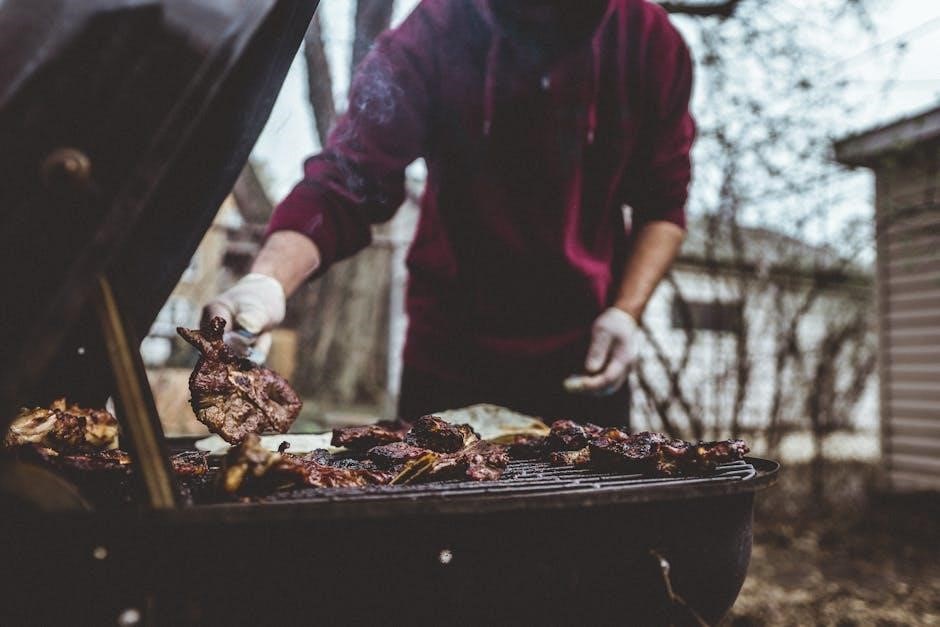
Wood Smoking Guide
Types of Wood for Smoking
Wood Pairing Recommendations for Different Meats
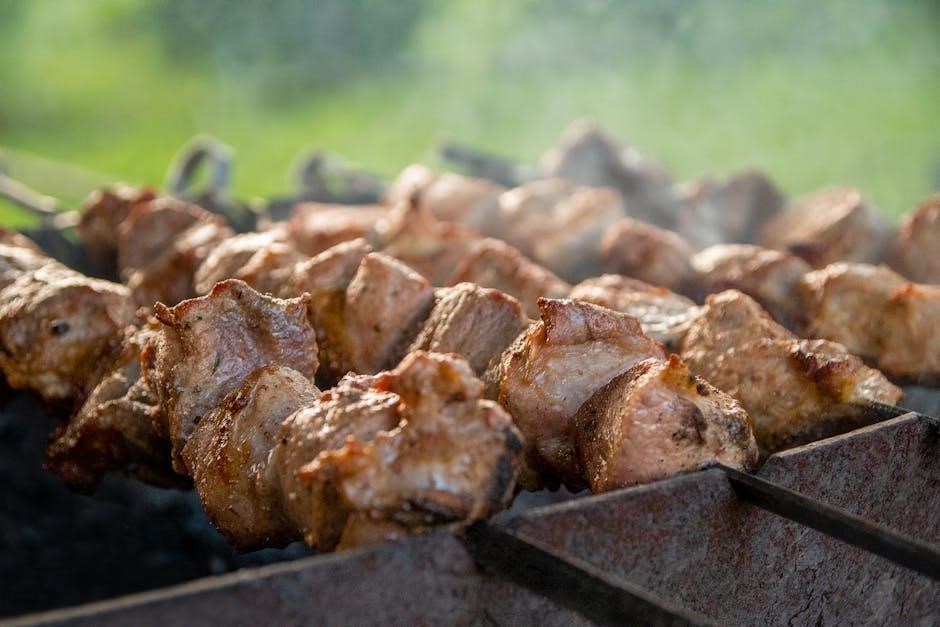
Meat Smoking Safety
Understanding the Danger Zone for Food Safety
Using Thermometers for Safe Smoking
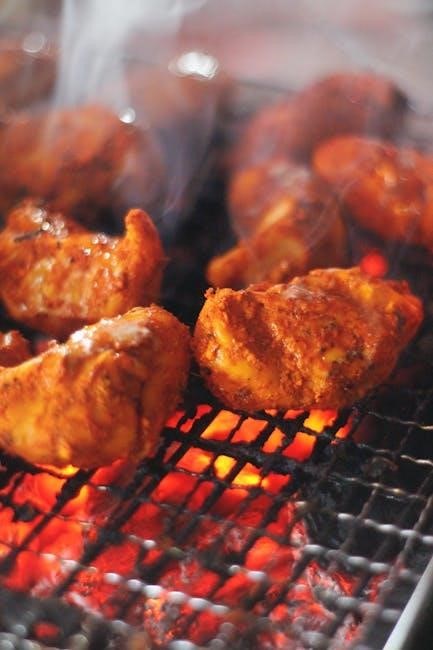
Creating a Smoking Chart PDF
Key Elements to Include in a Smoking Chart
Designing a Printable Smoking Chart
Best Practices for Using a Smoking Chart
Final Tips for Achieving Perfect Smoked Meats
